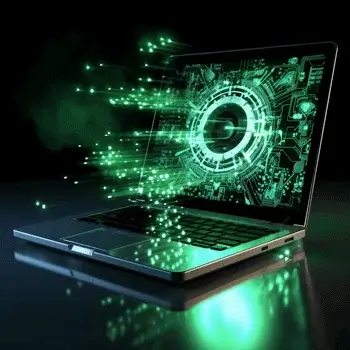Spyware: A Comprehensive Protection Guide
According to the AV Test Institute, over seven million new types of malware are detected each month – and the number keeps growing. Spyware makes up part of this alarming statistic. It’s a threat that’s always there on the Internet, whether we know it or not. In this article, learn what spyware is, how to prevent it, and how to remove it if your device is compromised.
Have My Accounts Been Compromised?
What is spyware?
Spyware is a type of malicious software that enters your computer without your knowledge. Once on your computer, it steals information and harms your system, slowing it down and disrupting files and programs. Spyware sometimes appears as a type of scareware, as it may urge users to download malicious software with promises of preventing future problems on their device.
What does spyware do?

Spyware works to collect your personal information without your knowledge once it's on your computer. It uses that stolen data for malicious purposes, such as advertising or third-party sales. All of your private information is vulnerable: your passwords, bank account information, credit card numbers, and any other data you have stored in your computer. As a result, spyware infections can lead to credit card fraud, stolen accounts, or even personal identity theft.
Spyware also harms your computer, as it is a form of malware. It can infect files or programs that impact system performance as it seeks to gather as much personal data as possible. Good spyware is difficult to detect and erase from a device, meaning that spyware damage can compound over time as the victim remains unaware of the infection.
Types of spyware
Cybercriminals have different targets, and thus, there are different types of spyware to target different types of data. See below for a summary of the different types:
- Keyloggers. These programs capture all keystrokes on your keyboard as you browse the Internet. But in addition to keystrokes, they can detect your website visits, sent and received emails, login credentials, and more. Essentially, it's as if the hacker were sitting next to you, watching your every movement on your computer or phone.
- Infostealers. These programs scan devices to find information held in the files. This includes usernames and passwords, email addresses, browsing history, documents, media files, and more. The hacker essentially has free access to all of your file folders.
- Password stealers. This type of program is designed specifically to steal passwords, like system credentials and online account logins. It also seeks access to your password manager if you use one.
- Cookie stealing. Cookies on their own aren’t spyware, though they do collect data about users. But hackers can use cookies to steal your data by falsifying or intercepting cookies on popular websites. They use the information from the cookies to harm you.
Stalkerware is another type of spyware as it also operates without the victim’s knowledge. It consists of any kind of spyware that monitors a person without their consent or knowledge.
How is spyware installed?
Spyware operates covertly, and as such, it installs without users’ knowledge. The point of this type of malware is to remain undetected by the user while still gaining maximum access to users’ technology. This means users need to be aware of all potential spyware gateways to try and prevent an infection from occurring.

Spyware often installs itself on a computer through one of the following ways:
- Phishing attacks. Phishing involves user action that “allows” software installation, like clicking a link on a spam email. Spyware often joins itself to an email attachment or message as a link or download, and once the user performs the necessary action, the spyware downloads itself.
- Deceptive advertisements. Some hackers advertise their spyware programs as antivirus software or other useful tools. Don’t download something you find for free on the Internet, even if it does advertise itself as a “hard drive cleanser” or “download manager.” In many cases, downloading this free software downloads spyware or other malware instead.
- Vulnerabilities and backdoors. Unlike phishing attacks or deceptive advertisements, these don’t involve user action. All systems have specific vulnerabilities; hackers learn how to find and exploit these vulnerabilities to install malware.
- Trojan horse malware. Trojan horse malware pretends to be something that it’s not. It masquerades as a useful tool or harmless download, but once it enters your computer system, it gains control and manipulates programs.
- Hard drives or other hardware. Spyware and other malware can also be installed physically via a hard disk drive. Juice jacking, for example, transfers malware via connected phone chargers.
Once malware is installed, it can slow down your computer, take up memory space, and change the registry on systems with Windows installed. The software is destructive; it steals information, damages files, and tracks data about both the system and its users. Because it does these things without your knowledge, it’s even harder to purge from your system.
How to prevent spyware
As with all types of malware, preventing infection is easier than removing one after the fact. The list below includes the best ways to avoid encountering spyware.
- Don’t open emails from unknown senders. These often contain malware or malicious links.
- Don’t download files from suspicious sources. Likewise, these links aren’t trustworthy and could infect your computer.
- Never click pop-up ads. Some pop-up ads redirect to untrustworthy or malicious websites, which could infect your computer.
- Use a reputable cybersecurity program. Some security programs are fronts for malware, but reputable programs provide great defense against threats.
- Avoid unsecured WiFi. Free or public WiFi could potentially allow a hacker to infect your computer across the network.
- Read app and program permissions before downloading. Reading what you’re agreeing to will ensure you aren’t accidentally downloading something malicious.
Consider looking for a cybersecurity program with real-time protection. Real-time protection blocks spyware and other malware threats as they occur, not after they’ve already accessed your information.
How to detect and remove spyware
Worried you have a spyware infection? If you do, your computer is likely showing a few symptoms, even if you don’t realize it. You can use an antivirus program to scan your computer and detect any malware infections, but before you do that, you can also check your computer for signs of an issue. Look for these signs of a spyware infection:
- Decreased device speed
- Alerts that you’re running out of space on your computer
- Incessant or new pop-up ads
- Difficulty logging into your device
- Increases in your data or bandwidth usage
- Faster loss of battery
- Frequent crashes when using your device
If you’ve noticed your computer has displayed a few of these symptoms recently, it’s possible you have a spyware infection. You will need the help of a removal tool to clear the malware from your operating system.
To remove spyware, download a high-quality antivirus and cybersecurity program and run a scan. It will detect and remove any malware on your device. Research to find the program that’s best for you; we recommend Norton, AVG, Avast, MalwareBytes, Bitdefender, and Spybot. All of these are thorough, safe programs that help get rid of spyware and keep your device operating as it should. Many of these also have apps for iPhone or Android devices if you have a mobile spyware problem.
Once the initial scan is over, run a second scan to make sure no secondary infections were missed in spyware removal. After performing the scan, clear your DNS cache and browser caches to prevent accidentally returning to the site or message where you got the spyware. If you believe your information was stolen, contact the proper authorities and freeze your credit if necessary.
Because all malware is a threat to your online safety, make sure to stay on top of your device’s protection. Though it can seem overwhelming, prevention steps go a long way in keeping you and your information safe.